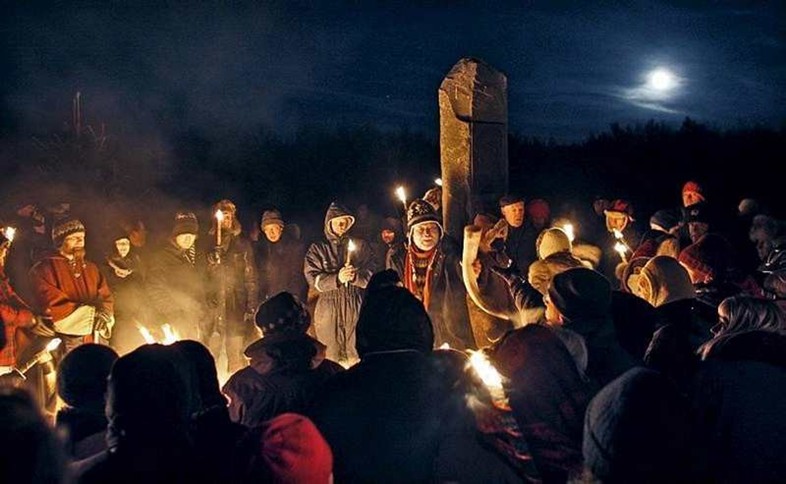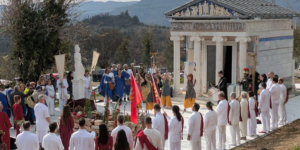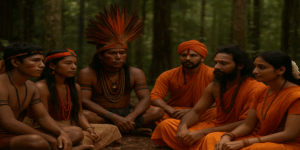As Iceland begins construction of its first pagan temple in over 1,000 years, we speak to the high priest of the country’s fastest growing spiritual movement
That Icelanders wear their spirituality proudly on their sleeves is nothing new. The country’s vigorous creative scene has for decades produced music that seems permeated with an almost palpable connection to its mystical volcanic landscapes. So perhaps it shouldn’t come as a surprise that the fastest-growing spiritual community in Iceland is the neo-pagan association of Ásatrú, a polytheistic religion committed to honouring not only ancient Icelandic faith and culture, but also the country’s natural heritage. This month the movement’s rapid expansion is being manifested in a truly epic way, as the Ásatrú Association begins building a new temple for worshipping the Old Norse gods – the first of its kind to be raised on Icelandic soil since Christianity replaced paganism over 1,000 years ago.
Before you start speculating about whether the rise of neo-paganism is a by-product of pop culture’s current fascination with hard-bodied Vikings and steamy medieval sagas: the modern Icelandic Ásatrú Association was recognised as an official state religion already in the early 1970s. It has grown steadily ever since, but has in the last decade seen a sixfold increase in memberships. And while the wider movement has yielded a variety of groups across the Western world, this branch seems to have taken on a particularly non-doctrinal character: Icelandic Ásatrúers place a strong emphasis on individual interpretation and personal responsibility.
At the helm of Iceland’s Ásatrúarfélagið’s is an appropriately unexpected figure: Hilmar Örn Hilmarsson, a pioneering composer best known for his work with such Icelandic musical royalty as Björk and Sigur Rós, has held the title of high priest for the past 12 years. We called him up to find out more about what the new temple means for the Icelandic Ásatrú community, and why this ancient set of values seems to be attracting an ever-growing number of people.
What is Icelandic Ásatrú, and who make up this community?
Hilmar Örn Hilmarsson: Ásatrú is a pre-Christian religion that was prevalent in Northern Europe over 1,000 years ago. It actually dates back much longer than that: it has roots in Hinduism and old Persian beliefs, but it moved to Northern Europe and mingled with indigenous beliefs that were being practiced here in Iceland in the Bronze Age. So it’s a very old set of beliefs with diverse cultural roots. Today, there are Ásatrú groups in most of Scandinavia but none have flourished like the one here in Iceland. We currently make up 1% of the nation – over 3,000 people are signed members. But according to research by the Iceland University, more than 40% of the population are sympathetic and would align themselves to our beliefs.
What constitutes the central beliefs of Ásatrú?
Hilmar Örn Hilmarsson: We place great emphasis on the Edda poems written by Snorri Sturluson in the 13th century. These are poems that contain ancient wisdom about how to lead your life and see the world around you. At the same time this is a polytheistic religion, which means every person has a unique approach. Some believe in the literal existence of the gods, other people see them as archetypes or symbolic forces. I think a lot of people find a connection to Ásatrú because it has such an individual approach. It’s not dogmatic and does not have you submit to any one truth, but lets you work out your own path. Ásatrú is really about real values: friendship, family and hospitality.
“We were actually the only religious body in Iceland that warned about the upcoming crises. Hávamál (a key verse among the Edda poems) warns explicitly against greed” – High priest Hilmar Örn Hilmarsson
Why did you decide to build this temple now?
Hilmar Örn Hilmarsson: The idea actually came up over 40 years ago, but it’s something we’ve been planning consistently for around 12 years. We presented the proposal to the city of Reykjavik in 2003, and a few years later we were given a piece of land in the hillsides of the city. Since then, all our plans have been built around this specific location and how the sun moves around it. The temple will be finished in the autumn of 2016, and will host all our seasonal ceremonies and ritual gatherings. I’m glad to say this temple will symbolize that Ásatrú has become a perfectly acceptable part of our society, and that we are respected for our contribution to Icelandic culture.
How do you explain the recent surge in interest in the Ásatrú faith in Iceland?
Hilmar Örn Hilmarsson: On the one hand, the number of ceremonies we do has grown, so I think more and more people have simply been exposed to what we do. We’ve had a lot of people join us after seeing that what we do is full of dignity and passion – that it’s nothing anachronistic or crazy, but something with real substance that people can relate to. I also think this is a set of beliefs that speaks on a particularly emotional level to us Icelanders. We’ve always had a strong pantheistic outlook here, because we’re constantly being humbled by our surroundings. I think we try to live in harmony with nature, and Ásatrú is a natural continuation of that principle.
“If you read Hávamál, it’s about how to meet other cultures and be a good guest or host to the world around you. These are ancient sayings for the traveller – not for the guy sitting at home on his ass thinking his living room is the centre of the world” – Hilmar Örn Hilmarsson on racism
Do you think there might also be a connection between the revival of these ancient values and a sense of disillusionment left by Iceland’s recent economic downturn?
Hilmar Örn Hilmarsson: Yes, I definitely think so. We were actually the only religious body in Iceland that warned about the upcoming crises. Hávamál (a key verse among the Edda poems) warns explicitly against greed, and we were particularly vocal in warning against the damaging effects that aluminium smelting by multinational companies would have on the Icelandic highlands. We were really a lone voice in in speaking up against many of these issues, but I think people later realised that we foresaw some of the catastrophes that followed.
There is, unfortunately, a certain association of the neo-pagan movement with nationalist and racialist ideas, particularly among some American groups. Have you had any negative experiences with similar tendencies in Iceland?
Hilmar Örn Hilmarsson: Icelandic Ásatrú has nothing to do with those paths that engage with politics or the doctrines of racial preservation. In fact, I get more hate mail from American so-called Ásatrúers than anyone other religious groups. I think that’s telling. If you think about it, we had no conception of nationhood back in the 9th century, when our values began taking shape. If you read Hávamál, it’s about how to meet other cultures and be a good guest or host to the world around you. These are ancient sayings for the traveller – not for the guy sitting at home on his ass thinking his living room is the centre of the world.
































